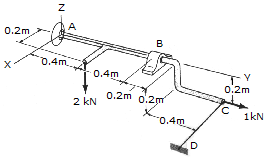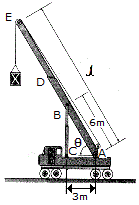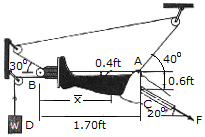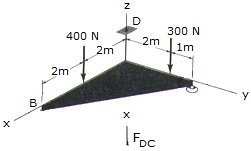Engineering Mechanics - Equilibrium of a Rigid Body
- Equilibrium of a Rigid Body - General Questions

There is a ball and socket connection at A. At point B there is a connection that opposes motion in the x and z directions only. Determine the unknown force components at A and B. Use a scalar analysis.

Determine the horizontal and vertical components of reaction at the pin A and the reaction at the roller support B required for equilibrium of the truss.

The crane provides a long-reach capacity by using the telescopic boom segment DE. The entire boom is supported by a pin at A and by the telescopic hydraulic cylinder BC, which can be considered as a two-force member. The rated load capacity of the crane is measured by a maximum force developed in the hydraulic cylinder. If this maximum force is developed when the boom supports a mass m = 6 Mg and its length is l = 40 and  = 60°, determine the greatest mass that can be supported when the boom length is extended to l = 50 m and
= 60°, determine the greatest mass that can be supported when the boom length is extended to l = 50 m and  = 45°. Neglect the weight of the boom and the size of the pulley at E. Assume the crane does not overturn. Note: when
= 45°. Neglect the weight of the boom and the size of the pulley at E. Assume the crane does not overturn. Note: when  = 60° BC is vertical; however, when
= 60° BC is vertical; however, when  = 45° this is not the case.
= 45° this is not the case.

A Russell's traction is used for immobilizing femoral fractures C. If the lower leg has a weight of 8 lb, determine the weight W that must be suspended at D in order for the leg to be held in the position shown. Also, what is the tension force F in the femur and the distance  which locates the center of gravity G of the lower leg? Neglect the size of the pulley at B.
which locates the center of gravity G of the lower leg? Neglect the size of the pulley at B.

There is a ball and socket connection at A. At B there is a roller that prevents motion in the —z direction. Corner C is tied to D by a rope. The triangle is weightless. Determine the unknown force components acting at A, B, and C. Use a scalar analysis.